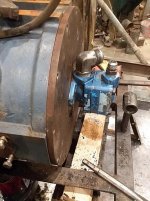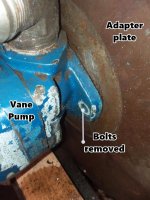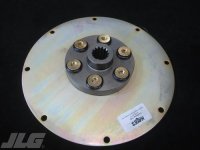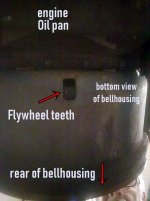I mentioned a few weeks ago about getting this little V.M. Motori Detroit / Sun model 2105E1 air cooled 2 cylinder diesel. Made in Italy, the company was absorbed by Detroit years ago, then spun off for some reason.
Anyhow...this engine drives a vane pump. I've drained the hydraulic system, so there is no oil available to the pump. I want to remove the pump so I can get the engine running, not wanting to power the pump dry.
That would be detrimental to the pump, wouldn't it?
Anyhow, I figured that I would unbolt the pump and pull it and the coupling half out and set it aside.
Well, that didn't happen.
Pump will not come away from that adapter plate one iota.
Removed all the bolts holding the adapter plate to the bell housing, and that plate won't back away more than a few thousandths. It won't rotate, either. I looked real close and didn't find any holes that may contain a locating pin or dowel. The plate won't wiggle or twist or anything... .like there may be some protrusions on the inside of the plate to locate it in relation to the flywheel or whatever's inside that bell housing.
Unbolted, the pump will freely rotate around it's axis, but won't slide back ANY!
Anyhow, I'm stumped. I've tried driving the plate back with the edge of a chisel hitting on the edge of the plate. I've tried pulling on the pump with my hand while I tap the sides of the pump with a ball pein.
Unless the pump shaft and it's coupling are just a real tight tolerance.. I can't imagine why I can't jar it loose. Nothing's giving..
I took some pics and put info on them to show what I'm talking about.



Anyhow...this engine drives a vane pump. I've drained the hydraulic system, so there is no oil available to the pump. I want to remove the pump so I can get the engine running, not wanting to power the pump dry.
That would be detrimental to the pump, wouldn't it?
Anyhow, I figured that I would unbolt the pump and pull it and the coupling half out and set it aside.
Well, that didn't happen.
Pump will not come away from that adapter plate one iota.
Removed all the bolts holding the adapter plate to the bell housing, and that plate won't back away more than a few thousandths. It won't rotate, either. I looked real close and didn't find any holes that may contain a locating pin or dowel. The plate won't wiggle or twist or anything... .like there may be some protrusions on the inside of the plate to locate it in relation to the flywheel or whatever's inside that bell housing.
Unbolted, the pump will freely rotate around it's axis, but won't slide back ANY!
Anyhow, I'm stumped. I've tried driving the plate back with the edge of a chisel hitting on the edge of the plate. I've tried pulling on the pump with my hand while I tap the sides of the pump with a ball pein.
Unless the pump shaft and it's coupling are just a real tight tolerance.. I can't imagine why I can't jar it loose. Nothing's giving..
I took some pics and put info on them to show what I'm talking about.












